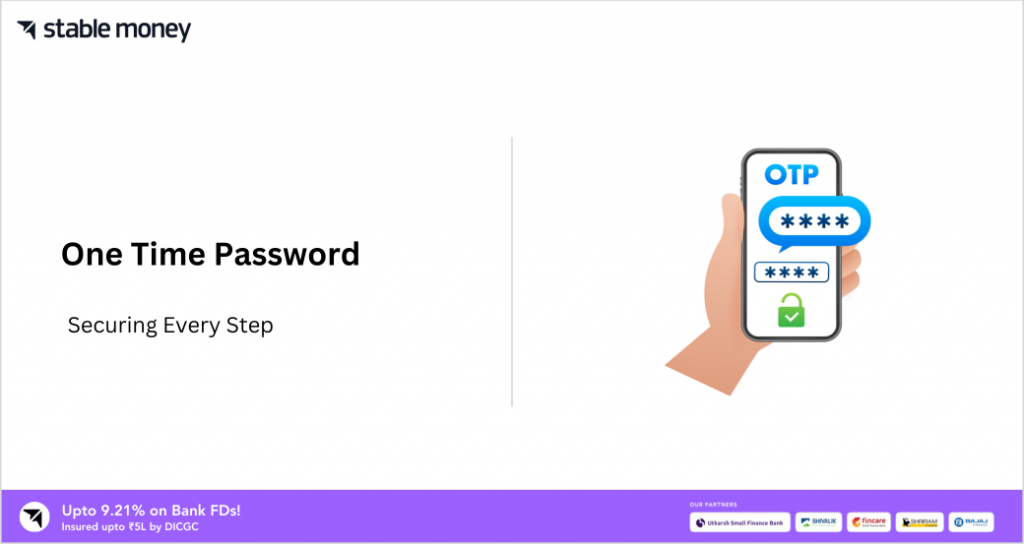
One-time passwords, or OTPs, have rapidly grown in use over the past few years, providing that added layer of authentication security when logging into critical online accounts. From banking to emails and beyond, OTPs are helping to curb the threat of account takeovers and financial fraud. This blog will discuss the various aspects of OTPs in detail.
What is One Time Password & its Example?
A one-time password is a password that is valid for only one login session or transaction. It is an extra security step for logging into accounts. When you enter your username and regular password on a website, it will send you a random code as an SMS or email. You must enter that code, username, and password to log in. It helps ensure that even if someone steals your regular password, they cannot access your account without access to the device where the one-time password is sent.
Working Of One Time Password
The working of OTP is quite simple. Once you log in to your account with your username and password, the website or app will send a random numeric code to the registered phone number or email as an SMS or email. This one-time password is usually valid for 30 seconds. To access your account successfully, you must manually enter this code on the login page, along with your username and regular password. The one-time password changes every time you log in, adding an extra layer of security to your online transactions and logins.
How is One Time Password Created
Understanding how OTP is created can help you see how the extra security layer works. When you request login access, the website:
- Generates a random numeric code between 6-8 digits long.
- Sends this one-time password to your registered device via SMS or email.
- The code is timestamped and encrypted to prevent theft and misuse.
- It is different every time you log in, so it cannot be reused even if stolen.
- Once entered on the login page within the timeout period, it is validated and matched at the server end.
- If matched, it allows access; if not, login is denied for security.
What is Single-factor Authentication & Two-factor Authentication. How it is Related With OTP
Single-factor authentication relies only on passwords to verify identity but leaves accounts vulnerable to hacking. Two-factor authentication adds an extra layer of security beyond passwords. It requires two methods to authenticate – something you know (like a password) and something you have (like your phone). Time Password or OTP enables two-factor authentication when logging into accounts by pairing a password with a randomly generated number sent dynamically to the registered device. Using both improves security significantly, as even if one factor is compromised, the other is still needed to access the account.
At What Pace OTP Industry is Growing in 2024?
The OTP industry has seen tremendous growth in recent years as more users and companies recognize the importance of two-factor authentication. Many major online platforms now support OTP for login for added security. The widespread adoption of two-factor authentication using OTP is predicted to further accelerate due to rising cybercrime. As people conduct more transactions virtually, the need for robust identity verification like OTP will continue to increase considerably.
Is Something More Secure as Compared to OTP in 2024
While OTP provides more robust security than single-factor authentication, some technologies claim to offer protection beyond OTP. Biometric authentication using fingerprints or face recognition is one option since it is harder to steal someone’s biometrics than to steal their phone. Security keys with cryptographic chips like USB drives provide another level of assurance. However, for most online transactions, OTP still stands as a very secure and user-friendly second-factor authentication method.
Why One-Time Password is Safe?
A one-time password is secure because it is randomly generated each time and is only valid for a single login session. Even if someone could steal the OTP, it would be useless as it expires quickly. The password also cannot be predicted or reused. Coupling OTP with a username and password makes unauthorized access extremely difficult, even if one of the factors is compromised. The transient nature of one-time passwords adds an essential layer of protection for user accounts and online transactions.
What is TOTP?
TOTP (Time-based One-Time Password) is a type of two-factor authentication that generates one-time passwords based on time rather than single-use codes. It uses a shared secret key and the current time to produce a password valid for 30 seconds.
Difference Between OTP & TOTP
| OTP | TOTP |
|---|---|
| Code valid for single login session | Password valid for 30 second time interval |
| Password sent via SMS/email | Generated using an algorithm based on the current time |
| It depends on the network for delivery | Works offline since codes self-generated |
What is the Static Password?
A static password is a fixed password that remains the same each time you log into an account. It does not change unless reset by the user. Though more convenient, using the same password leaves accounts vulnerable if the password is compromised.
Difference Between Static Password & OTP
| Static Password | OTP |
|---|---|
| Password remains same for all logins | A new one-time code is generated every login |
| Higher security risk if the password is stolen | Even if stolen, code expires and cannot be reused |
| It can be reused for malicious purposes | Single-use ensures greater safety |
| No additional layer of security | Provides two-factor authentication |
Difference Between HOTP & TOTP
Both HOTP and TOTP are one-time password authentication methods used for multi-factor authentication. They generate rotating codes for logging into accounts without using static passwords. The main difference lies in how the codes are generated.
| Particular | HOTP | TOTP |
|---|---|---|
| Code Generation | Based on Counter | Based on time |
| Counter Required | Yes | No |
| Validation Timeframe | Flexible | Strict time window |
| Re-syncing Required | On counter loss | Not needed if clocks are in sync |
How Many Cases of Financial Fraud are Dropped After the Advent of OTP
Implementing OTP for online banking and financial transactions has led to a significant drop in reported fraud cases. With OTP adding an extra layer of security validation beyond passwords, it has become much more complicated for fraudsters to access people’s financial accounts without consent. Banking institutions have seen authentication-related fraud complaints reduced by over 30% after implementing OTP-based authentication. The immediate one-time codes help identify unauthorized login attempts immediately, stopping many fraud attempts in their tracks.
Things Included in OTP
An OTP typically includes six digits, randomly generated each time a new code is required. These one-time use numbers are sent via SMS to a registered phone or email address. Sometimes, an authenticator app is also used to generate the random codes. Proper details ensuring the codes are used securely and discarded after each login attempt are highlighted when OTPs are provided.
Importance of OTP
OTP provides that added layer of security during login. It is widely used to protect sensitive online accounts and services. Here are some key aspects highlighting the importance of OTP:
- Prevents unauthorized access to accounts even if the password is lost or stolen
- Immediate one-time codes help identify fraudulent login attempts
- No lists of pre-generated codes for hackers to breach through like regular passwords
- Stronger authentication than passwords alone for sensitive online transactions
Characteristics & Features of OTP
- Randomly generated one-time use 6-digit numbers.
- Delivered via SMS, email or authenticator app for login verification.
- Automatically generated codes require no manual entry of pre-set passwords.
- Time-based (TOTP) or counter-based (HOTP) generation methods.
- Short validity windows of 30-60 seconds force immediate login.
- It cannot be reused or compromised if stolen due to its one-time nature.
Advantages & Disadvantages of OTP in 2024
1. Advantages of OTP
- Provides robust security with two-factor authentication beyond passwords.
- Login authentication is instant with one-time use codes.
- Even if the password is lost or stolen, accounts cannot be accessed.
2. Disadvantages of OTP
- Reliance on SMS delivery can be unreliable in some cases.
- The extra step of entering codes may be seen as inconvenient by some.
- Requirement of authenticator apps on additional devices for TOTP.
- It is not compatible with older devices without authenticator app support.
- Costs involved for SMS delivery in significant volume usage situations.
Final Word
OTPs have significantly boosted online login and transaction security by providing dynamic, one-time-use credentials beyond static passwords. While not perfect, the advantages of their additional authentication layer far outweigh any minor disadvantages. Wider adoption of OTP protections will undoubtedly curtail the impact of bad cyber actors in the future.
FAQs
A one-time password is a randomly generated 6-digit number valid for only one login session.
The OTP method generates dynamic credentials on devices or through SMS/email to authenticate users in addition to their existing passwords.
Your OTP password refers to the unique 6-digit code randomly generated for your account that must be entered along with your regular password to log in.
Many major online service providers use OTPs for login verification in addition to passwords to add an extra layer of security.
An OTP is usually valid for a concise window, 30-60 seconds, after which a new code is generated for the next login attempt.
Disclaimer
This article is solely for educational purposes. Stable Money doesn't take any responsibility for the information or claims made in the blog.

